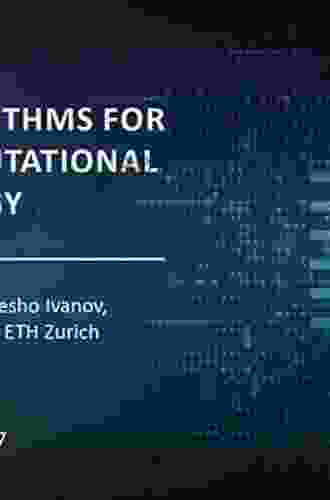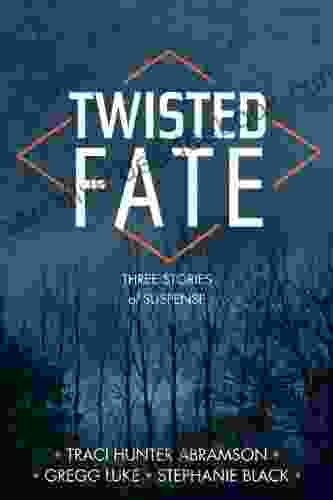Algorithms For Computational Biology: A Comprehensive Overview

Computational biology is a rapidly growing field that utilizes computational methods to analyze and interpret biological data. Algorithms play a vital role in computational biology, enabling researchers to perform complex tasks such as sequence alignment, gene expression analysis, and phylogenetic tree construction. In this article, we will provide a comprehensive overview of various algorithms used in computational biology, discuss their applications, and provide examples to illustrate their significance.
4.6 out of 5
| Language | : | English |
| File size | : | 20862 KB |
| Text-to-Speech | : | Enabled |
| Enhanced typesetting | : | Enabled |
| Print length | : | 165 pages |
| Screen Reader | : | Supported |
String Alignment Algorithms
String alignment algorithms are used to compare two or more DNA or protein sequences and find regions of similarity. These algorithms are essential for tasks such as gene identification, sequence assembly, and phylogenetic analysis. Common string alignment algorithms include:
- Needleman-Wunsch algorithm: A dynamic programming algorithm for global alignment, which finds the optimal alignment between two sequences over their entire length.
- Smith-Waterman algorithm: A dynamic programming algorithm for local alignment, which finds the optimal alignment between two sequences within a specified region.
- BLAST (Basic Local Alignment Search Tool): A heuristic algorithm for sequence comparison, which searches for regions of similarity between a query sequence and a database of sequences.
String alignment algorithms are widely used in computational biology. For example, the Needleman-Wunsch algorithm is used to align coding sequences to identify conserved regions and potential functional motifs. BLAST is used to search for homologous sequences in databases, such as GenBank, to infer evolutionary relationships and identify potential gene functions.
Sequence Analysis Algorithms
Sequence analysis algorithms are used to analyze the composition, structure, and patterns within biological sequences. These algorithms are useful for tasks such as gene finding, motif discovery, and genome assembly. Common sequence analysis algorithms include:
- Markov models: Statistical models that describe the probability of occurrence of a nucleotide or amino acid in a sequence based on the preceding nucleotides or amino acids.
- Hidden Markov models (HMMs): Extensions of Markov models that can capture hidden states within a sequence, such as coding regions or functional domains.
- Gibbs sampling: A Monte Carlo Markov chain algorithm for inferring the parameters of probabilistic models, such as HMMs.
Sequence analysis algorithms are widely used in computational biology. For example, HMMs are used to identify coding regions in DNA sequences and to predict gene structures. Gibbs sampling is used to infer the parameters of complex probabilistic models, such as those used for gene expression analysis.
Phylogenetic Tree Construction Algorithms
Phylogenetic tree construction algorithms are used to infer the evolutionary relationships between species based on their genetic data. These algorithms are essential for studying evolution, taxonomy, and conservation biology. Common phylogenetic tree construction algorithms include:
- Neighbor-joining method: A distance-based method that constructs a phylogenetic tree by joining pairs of taxa that minimize the total branch length.
- Maximum parsimony method: A method that constructs a phylogenetic tree with the shortest total branch length.
- Bayesian inference: A statistical method that constructs a phylogenetic tree based on the probability of observing the data under different evolutionary models.
Phylogenetic tree construction algorithms are widely used in computational biology. For example, the neighbor-joining method is used to construct phylogenetic trees for large datasets, while Bayesian inference is used to estimate evolutionary parameters and assess the uncertainty in phylogenetic trees.
Algorithms play a critical role in computational biology, enabling researchers to analyze and interpret biological data more efficiently. In this article, we provided a comprehensive overview of various algorithms used in computational biology, including string alignment algorithms, sequence analysis algorithms, and phylogenetic tree construction algorithms. We discussed their applications and provided examples to illustrate their significance. As the field of computational biology continues to grow, new and innovative algorithms will undoubtedly be developed to tackle the increasingly complex challenges in biological data analysis.
4.6 out of 5
| Language | : | English |
| File size | : | 20862 KB |
| Text-to-Speech | : | Enabled |
| Enhanced typesetting | : | Enabled |
| Print length | : | 165 pages |
| Screen Reader | : | Supported |
Do you want to contribute by writing guest posts on this blog?
Please contact us and send us a resume of previous articles that you have written.
 Book
Book Chapter
Chapter Text
Text Story
Story Genre
Genre Library
Library Paperback
Paperback E-book
E-book Sentence
Sentence Bookmark
Bookmark Foreword
Foreword Preface
Preface Manuscript
Manuscript Bestseller
Bestseller Library card
Library card Narrative
Narrative Biography
Biography Memoir
Memoir Reference
Reference Encyclopedia
Encyclopedia Dictionary
Dictionary Narrator
Narrator Character
Character Catalog
Catalog Card Catalog
Card Catalog Stacks
Stacks Study
Study Scholarly
Scholarly Lending
Lending Journals
Journals Reading Room
Reading Room Rare Books
Rare Books Special Collections
Special Collections Literacy
Literacy Thesis
Thesis Dissertation
Dissertation Storytelling
Storytelling Awards
Awards Book Club
Book Club Theory
Theory Bert Kastel
Bert Kastel Joni Mccoy
Joni Mccoy R E Canan
R E Canan Bruno Walter
Bruno Walter E Paul Zehr
E Paul Zehr Richard Day
Richard Day Mei Yu
Mei Yu Makala Thomas
Makala Thomas Lay Hwee Yeo
Lay Hwee Yeo Kyle Scott
Kyle Scott Fiona Morris
Fiona Morris Laura England
Laura England Gwenda Bond
Gwenda Bond Robert Spencer
Robert Spencer Andrew Boland
Andrew Boland Joe Thomas
Joe Thomas Lucy Ann Carroll
Lucy Ann Carroll Cornelia Mee
Cornelia Mee Kayla Brissi
Kayla Brissi Elisabeth Pfeiffer
Elisabeth Pfeiffer
Light bulbAdvertise smarter! Our strategic ad space ensures maximum exposure. Reserve your spot today!

 Isaac AsimovCall Across the Sea: The Heroes Quartet - A Timeless Tale of Love, Loss, and...
Isaac AsimovCall Across the Sea: The Heroes Quartet - A Timeless Tale of Love, Loss, and... Nathaniel HawthorneFollow ·10.9k
Nathaniel HawthorneFollow ·10.9k Forrest ReedFollow ·5.2k
Forrest ReedFollow ·5.2k Octavio PazFollow ·3.7k
Octavio PazFollow ·3.7k Jason ReedFollow ·12.9k
Jason ReedFollow ·12.9k Joshua ReedFollow ·2.5k
Joshua ReedFollow ·2.5k Ezekiel CoxFollow ·4.3k
Ezekiel CoxFollow ·4.3k Rodney ParkerFollow ·11.8k
Rodney ParkerFollow ·11.8k Isaias BlairFollow ·12.5k
Isaias BlairFollow ·12.5k

 Dallas Turner
Dallas TurnerParasols and Peril: Adventures in Grace
In the quaint town...

 Caleb Carter
Caleb CarterFlight Attendant Joe: A Dedicated Professional in the...
Flight Attendant Joe...

 Jerry Ward
Jerry WardPick Lottery The List For 23 States August 15 2024
The Pick Lottery is a multi-state lottery...

 Hudson Hayes
Hudson HayesHow the Media Wields Dangerous Words to Divide a Nation
In a world where the media is...

 Curtis Stewart
Curtis StewartThe Magic Mala: A Story That Changes Lives
In the realm of ancient traditions and...

 Raymond Parker
Raymond ParkerEarthly Meditations: A Poetic Tapestry of Nature,...
In the realm of contemporary...
4.6 out of 5
| Language | : | English |
| File size | : | 20862 KB |
| Text-to-Speech | : | Enabled |
| Enhanced typesetting | : | Enabled |
| Print length | : | 165 pages |
| Screen Reader | : | Supported |










